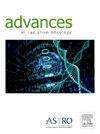Comprehensive Analysis of Treatment Approaches in Chest Wall Ewing Sarcoma: The Impact of Tumor Volume on Oncologic Outcomes
IF 2.2
Q3 ONCOLOGY
引用次数: 0
Abstract
Purpose
Local treatment with surgery (S) and radiation therapy (RT) for chest wall Ewing sarcoma (cwES) is often challenging given the extent of the tumor and the aggressiveness of local treatments needed for cure. We report tumor and treatment characteristics, oncologic outcomes, and toxicities of patients with cwES at 2 centers of a single institution.
Methods and Materials
Consecutive patients with cwES treated from 1997 to 2022 were retrospectively reviewed. All patients were treated with standard 5-drug chemotherapy (vincristine, doxorubicin, cyclophosphamide, alternating with ifosfamide and etoposide) before initiation of local therapy. Local treatment was S, RT, or both. The decision on modality and timing was determined by a multidisciplinary sarcoma group or by consensus between sarcoma experts regarding patient preferences.
Results
The cohort consisted of 39 patients. The median age at diagnosis was 19.2 years (range, 3.5-53.6 years). Median tumor volume (TV) was 235.5 mL (range, 5.3-6761.9 mL). The local control (LC) modality was S in 18 patients (46%), RT in 4 (10%), and S + RT in 17 (44%). Four (10%) patients treated with S + RT had R1 margins. The median follow-up was 3.2 years (range, 0.1-21.6 years). Grade 3 radiation-associated toxicity relative to the RT modality was 16.7% and 7.1% for photons (n = 6) and protons (n = 14), respectively. The 2-year LC by modality was 100% for RT (95% CI, 100%-100%), 88.2% (95% CI, 74.2%-100%) for S, and 73.3% (95% CI, 54.0%-99.5%) for S + RT. The 5-year LC, failure-free survival, and overall survival for all patients were 79.7% (95% CI, 67.3%-94.4%), 52.3% (95% CI, 38.1%-71.9%), and 64.2% (95% CI, 49.6%-83.1%), respectively. In univariate and multivariate analysis, TV ≥ 130 mL was associated with a significantly worse 5-year failure-free survival (31.8% TV ≥ 130 mL vs 80.8% TV < 130 mL; hazard ratio, 4.94, p = .013 and adjusted hazard ratio, 5.43; 95% CI, 1.28-22.98; p = .022). The multivariate model was adjusted for age, metastatic disease at diagnosis, and S.
Conclusions
Outcomes for cwES tumors are highly dependent on tumor size, even with the use of combined modality local therapy. With early follow-up, smaller tumors may be well controlled with either S or RT.
胸壁尤文氏肉瘤治疗方法的综合分析:肿瘤体积对肿瘤预后的影响
目的考虑到肿瘤的范围和局部治疗的侵袭性,胸壁尤文氏肉瘤(cwES)的局部手术和放射治疗(RT)通常具有挑战性。我们报告了同一机构的两个中心的cwES患者的肿瘤和治疗特征、肿瘤预后和毒性。方法与材料回顾性分析1997 - 2022年连续治疗的cwES患者。所有患者在开始局部治疗前均接受标准5药化疗(长春新碱、阿霉素、环磷酰胺,与异环磷酰胺和依托泊苷交替)。局部治疗为S、RT或两者兼而有之。治疗方式和时机的决定由多学科肉瘤小组或肉瘤专家就患者偏好达成共识。结果该队列包括39例患者。诊断时的中位年龄为19.2岁(范围为3.5-53.6岁)。中位肿瘤体积(TV) 235.5 mL(范围5.3 ~ 6761.9 mL)。局部对照(LC) 18例(46%)为S, 4例(10%)为RT, 17例(44%)为S + RT。4例(10%)接受S + RT治疗的患者有R1边缘。中位随访时间为3.2年(0.1-21.6年)。相对于放疗方式,光子(n = 6)和质子(n = 14)的3级辐射相关毒性分别为16.7%和7.1%。按模式划分的2年LC在RT组为100% (95% CI, 100%-100%), S组为88.2% (95% CI, 74.2%-100%), S + RT组为73.3% (95% CI, 54.0%-99.5%)。所有患者的5年LC、无故障生存率和总生存率分别为79.7% (95% CI, 67.3%-94.4%)、52.3% (95% CI, 38.1%-71.9%)和64.2% (95% CI, 49.6%-83.1%)。在单因素和多因素分析中,TV≥130 mL与5年无故障生存率显著降低相关(TV≥130 mL vs TV <;130毫升;风险比为4.94,p = 0.013,校正风险比为5.43;95% ci, 1.28-22.98;P = .022)。多变量模型根据年龄、诊断时的转移性疾病和年龄进行了调整。结论:cwES肿瘤的预后高度依赖于肿瘤大小,即使使用联合局部治疗方式也是如此。在早期随访中,小肿瘤可以通过S或RT得到很好的控制。
本文章由计算机程序翻译,如有差异,请以英文原文为准。
求助全文
约1分钟内获得全文
求助全文
来源期刊

Advances in Radiation Oncology
Medicine-Radiology, Nuclear Medicine and Imaging
CiteScore
4.60
自引率
4.30%
发文量
208
审稿时长
98 days
期刊介绍:
The purpose of Advances is to provide information for clinicians who use radiation therapy by publishing: Clinical trial reports and reanalyses. Basic science original reports. Manuscripts examining health services research, comparative and cost effectiveness research, and systematic reviews. Case reports documenting unusual problems and solutions. High quality multi and single institutional series, as well as other novel retrospective hypothesis generating series. Timely critical reviews on important topics in radiation oncology, such as side effects. Articles reporting the natural history of disease and patterns of failure, particularly as they relate to treatment volume delineation. Articles on safety and quality in radiation therapy. Essays on clinical experience. Articles on practice transformation in radiation oncology, in particular: Aspects of health policy that may impact the future practice of radiation oncology. How information technology, such as data analytics and systems innovations, will change radiation oncology practice. Articles on imaging as they relate to radiation therapy treatment.
 求助内容:
求助内容: 应助结果提醒方式:
应助结果提醒方式:


